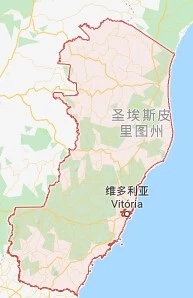The second largest coffee producing area in Brazil-Esp í rito Santo | status of Esp í rito Santo in Brazil

Although coffee was introduced to Brazil in the northern state of Para, most of Brazil's coffee production is currently in southeastern Brazil, mainly in Minas Gerais and Esp í rito Santo. Sao Paulo and Parana (click here to see Brazilian coffee) produce by state and region)
Esp í rito Santo is a smaller area than other Brazilian coffee producing areas, but it is the second largest in the country in terms of annual output. However, nearly 80% of coffee trees belong to Robusta. In the south of the area, farmers tend to produce Arabica, which has the potential to produce more interesting coffee.

For most of Brazil's history, at least externally, the definition of Brazilian coffee was mainly determined by its shipping port. Usually, high-quality coffee from St. Minas, Sao Paulo and Mojana is transported through Santos. Most of the coffee from Rio de Janeiro and Minas Gerais is transported through Rio de Minas. Considering the dry and humid conditions in these areas, coffee is often contaminated with phenolic defects, which in fact are called "rio" defects. The three levels of this defect are "riado (roughly translated as mild rio or rioy)", "rio" and "rio zona", which are named after coffee from Zona da Mata, which usually contains very strong rio defects.
However, relatively recent regions and micro-regions have begun to distinguish their regions by IG (Indica regions ã o Geogr á fica). Regi'ao do Cerrado Mineiro is the first Brazilian coffee region to obtain an appellation of origin, and other regions and Mantiqueira de Minas regions have also successfully completed this process, as well as several other processes.
Important Notice :
前街咖啡 FrontStreet Coffee has moved to new addredd:
FrontStreet Coffee Address: 315,Donghua East Road,GuangZhou
Tel:020 38364473
- Prev

FAZENDA CALIFORNIA Estates Washable New World Coffee Introduction| Brazilian coffee
FAZENDA CALIFORNIA 100% Washed New World Farm: California FAZENDA CALIFORNIA Breed: 100% New World Treatment: Washed Altitude: 800+ m Owner: Luiz Rodrigues Town Name: Jacarezinho Region: Norte Pioneer do Paran Country: Brazil Awards: 2
- Next

Introduction of Yellow bourbon treatment and Flavor characteristics of Queen Manor in Brazil
Fazenda Rainha is located in Brazil's Vale Vale da Grama, an ancient volcanic valley that straddles the border between Mogiana and Minas Gerais. We like coffee grown in ancient volcanic areas because the fresh soil is full of nutrients. The farm has undulating hillsides, dense trees and shady green leaves.
Related
- Detailed explanation of Jadeite planting Land in Panamanian Jadeite Manor introduction to the grading system of Jadeite competitive bidding, Red bid, Green bid and Rose Summer
- Story of Coffee planting in Brenka region of Costa Rica Stonehenge Manor anaerobic heavy honey treatment of flavor mouth
- What's on the barrel of Blue Mountain Coffee beans?
- Can American coffee also pull flowers? How to use hot American style to pull out a good-looking pattern?
- Can you make a cold extract with coffee beans? What is the right proportion for cold-extracted coffee formula?
- Indonesian PWN Gold Mandrine Coffee Origin Features Flavor How to Chong? Mandolin coffee is American.
- A brief introduction to the flavor characteristics of Brazilian yellow bourbon coffee beans
- What is the effect of different water quality on the flavor of cold-extracted coffee? What kind of water is best for brewing coffee?
- Why do you think of Rose Summer whenever you mention Panamanian coffee?
- Introduction to the characteristics of authentic blue mountain coffee bean producing areas? What is the CIB Coffee Authority in Jamaica?

